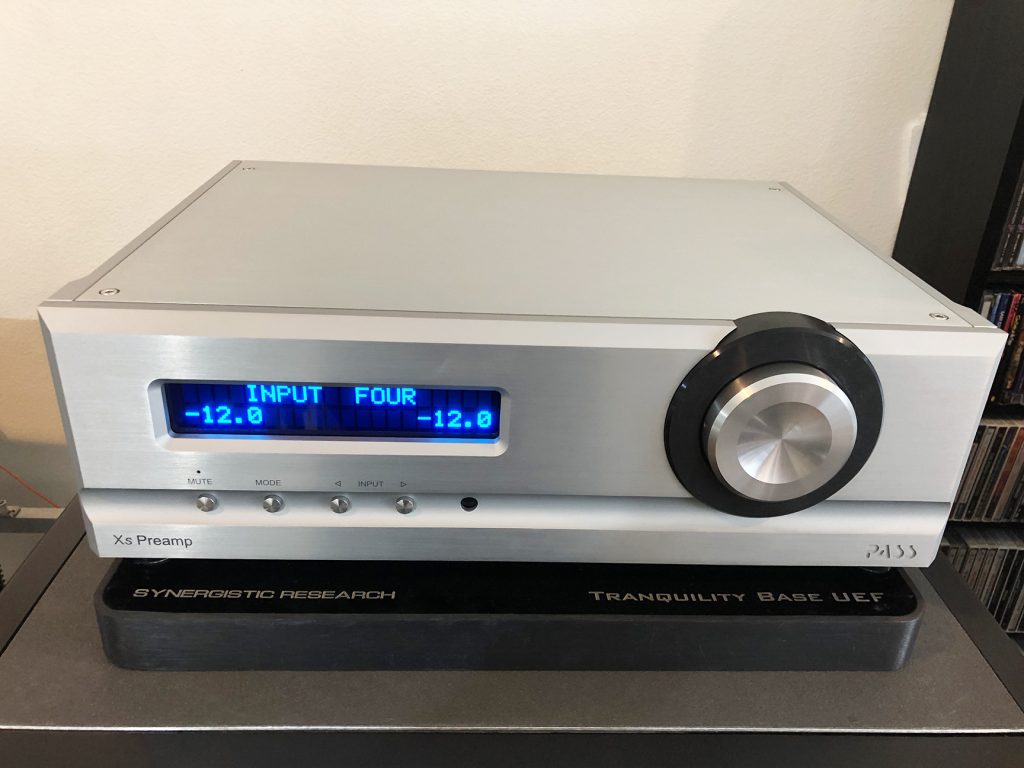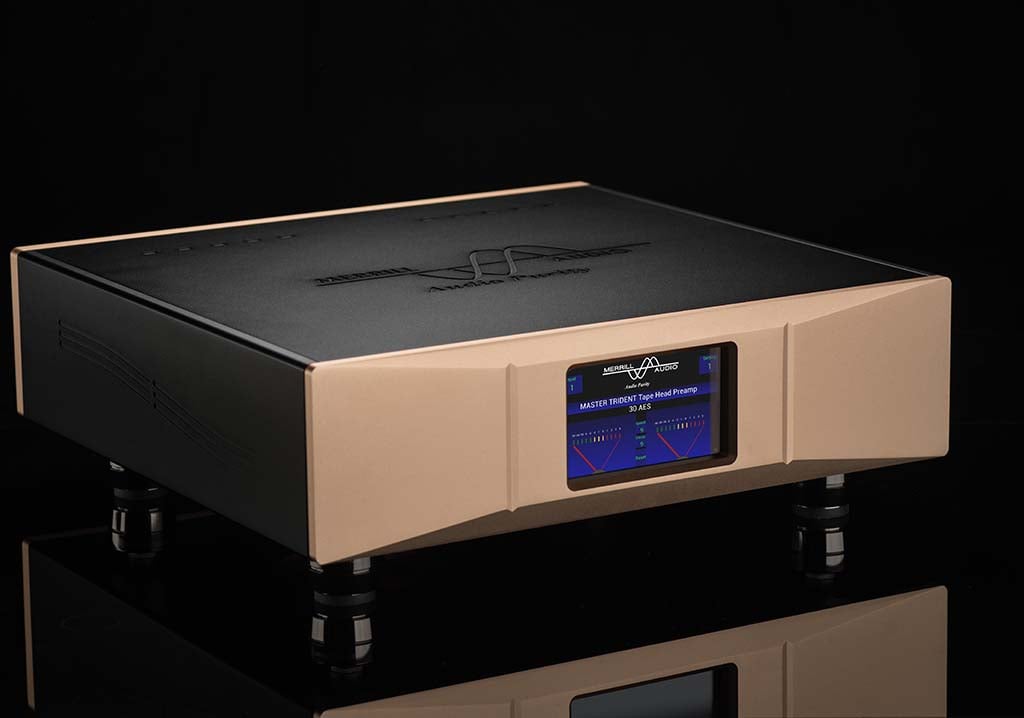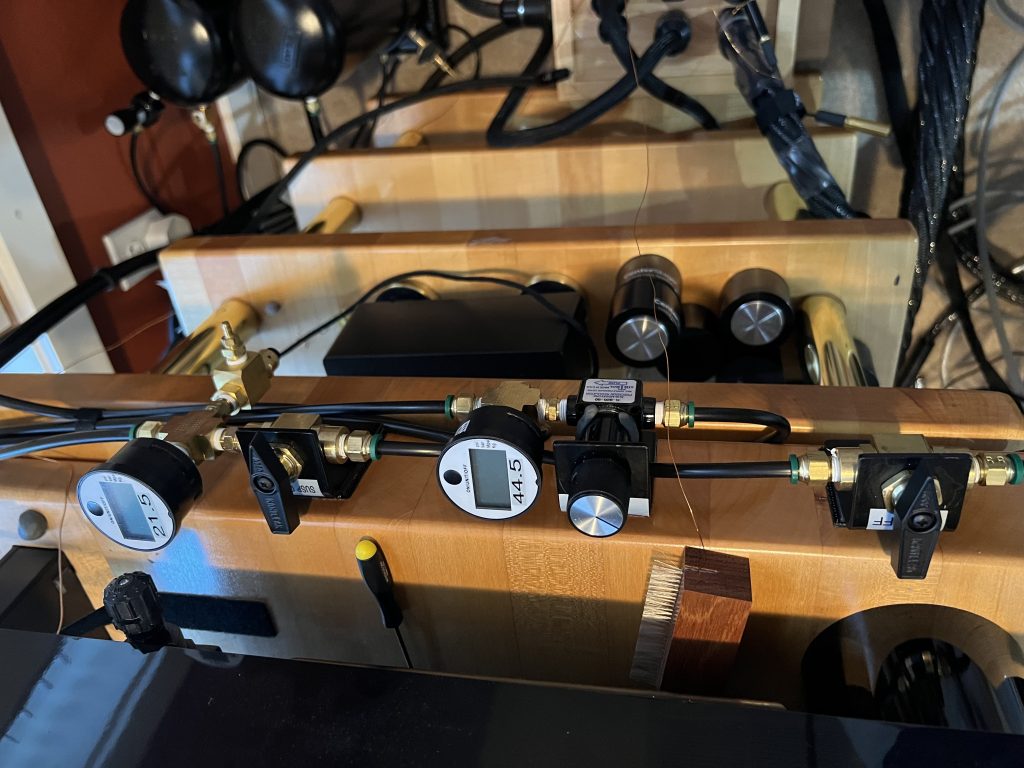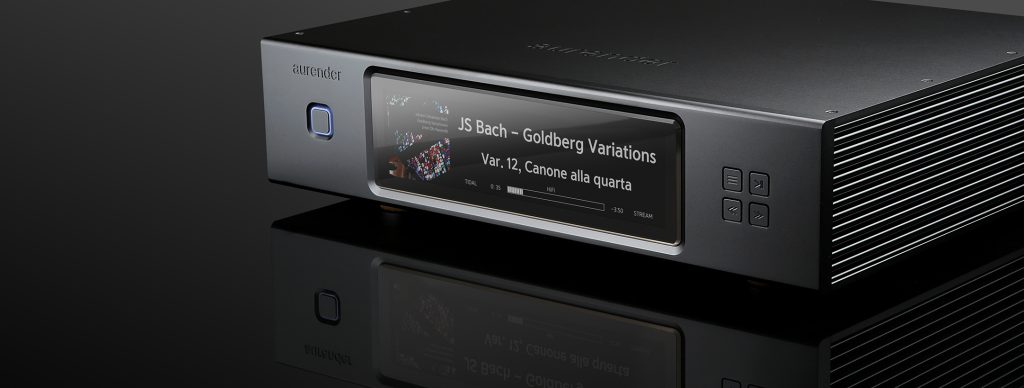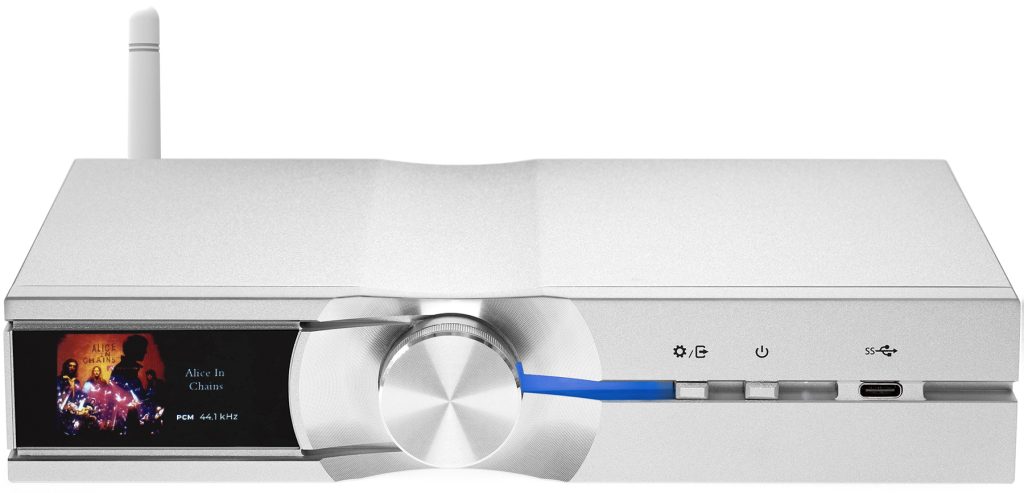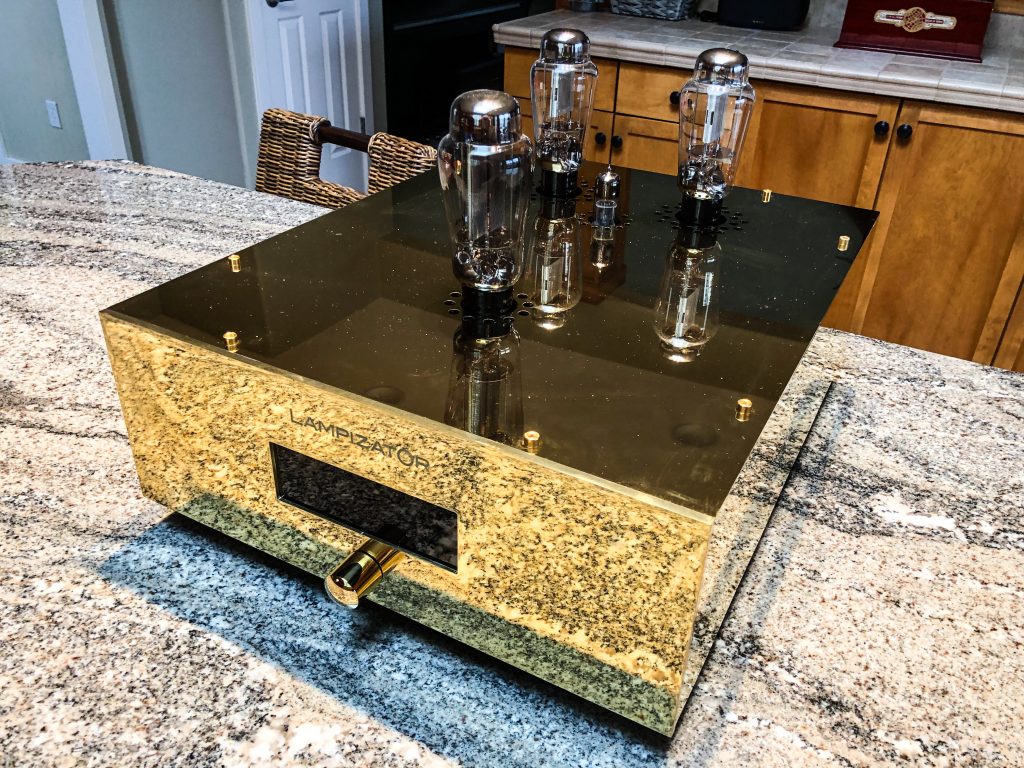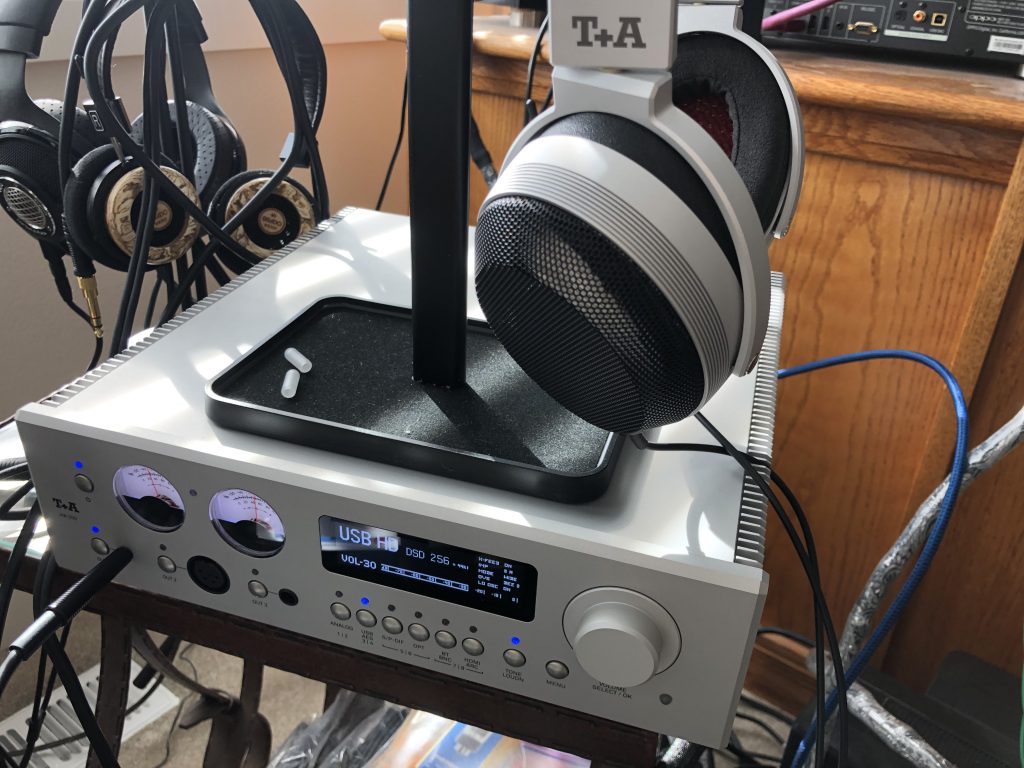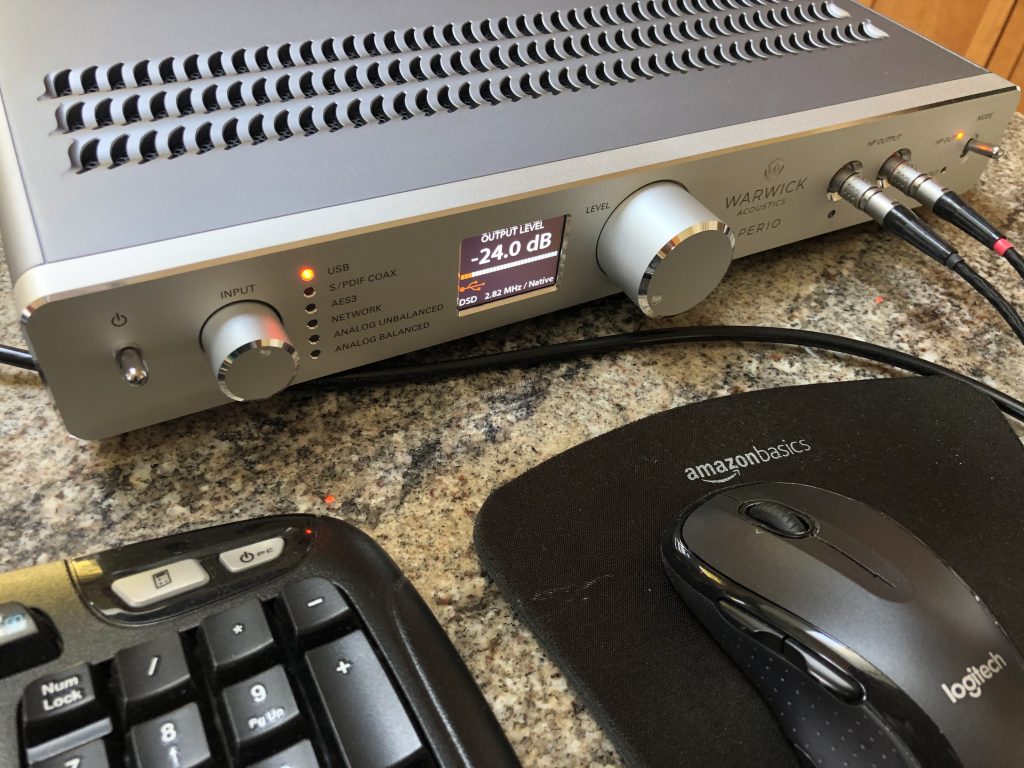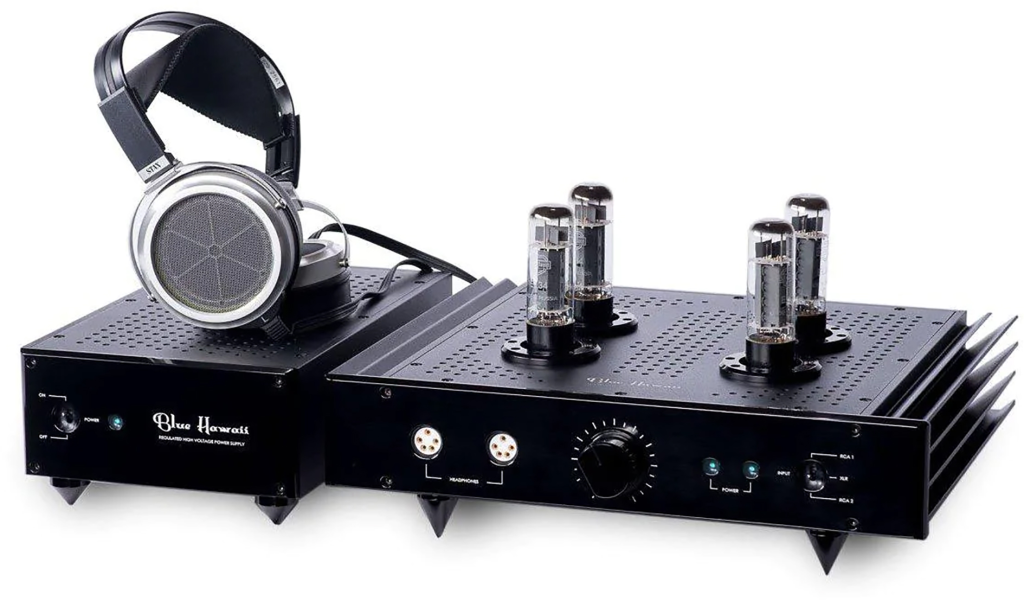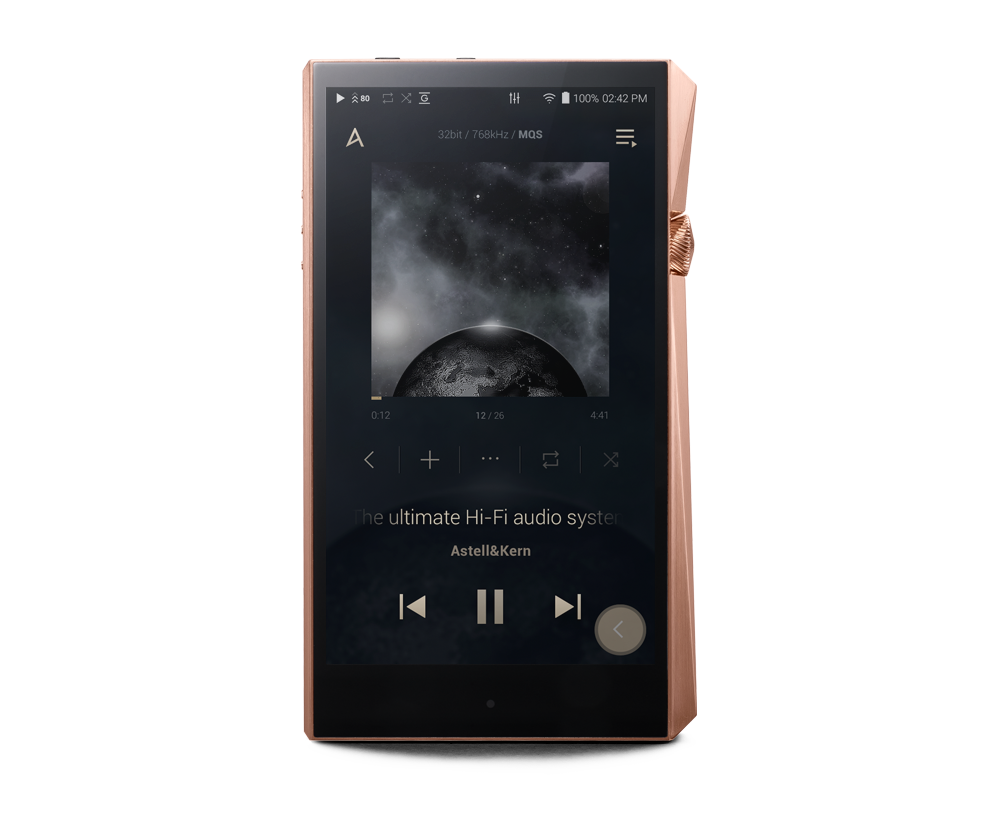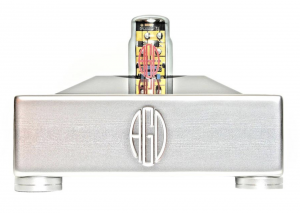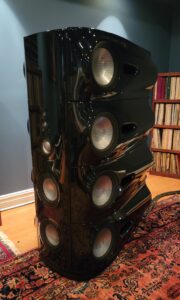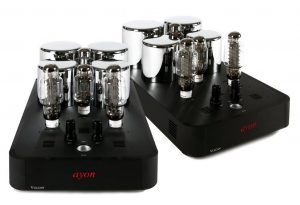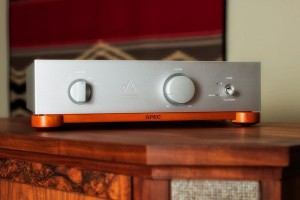Impressions: The AURALiC VEGA DSD DAC and TAURUS Mk. II Balanced Headphone Amplifier

The AURALiC VEGA DSD DAC (top) and TAURUS headphone amp (bottom) in tandem, on one of our reference Stillpoints ESS Grid Racks… lovely, lovely!
Once, and not so long ago (A year? Two?), I maintained a list of DSD DACs. After the establishment of the DSD-over-PCM (DoP) open standard, and the polishing of ASIO drivers for various DSD DACs, plus the growth of DSD download sites like SuperHirez.com, Channel Classics, DSDfile.com, and nativeDSD.com, the number of DSD DACs grew significantly. Now it's no longer necessary to track them…they are out there by the dozens.
One of the earlier comers to the DSD DAC game was an entry from AURALiC. I was not familiar with them, until last summer, when Bryan Stanton of JB Stanton, who specializes in introducing new and interesting brand names, got in touch with me about the product line. Was I interested in doing a review of the AURALiC VEGA, their new DSD DAC?
Well, sure. I wasn't familiar with the product line, but DSD DACs are a particular interest of mine, and I was quite willing to give it a go. I only wish that personal complications over the past year-plus had not delayed this project so badly. Both Dave Clark and I have gone through a lot over the past 1.5 years….
The VEGA and TAURUS arrive…

The AURALiC VEGA (Photo courtesy of AURALiC)
The AURALiC VEGA arrived, as did the TAURUS headphone amp, being personally delivered by the president of the home firm, Wang Xuanqian, accompanied by Bryan Stanton. We had a very solid conversation, and discussed his designs and his entry into the American market. So far, so good…a very determined audio designer and some great-looking audio gear…a promising foundation for a good review project.
First, the physical description. The VEGA is a distinctive looking DSD DAC. I haven't seen anything that looks quite like it: A handsome and trim aluminum case, with a dark OLED display area, a power indicator, and a single control knob to the right. Very clean; very attractive styling; for those looking for audio eye candy, the VEGA has it.

Rear section of the VEGA (Photo courtesy of AURALiC)
The rear section has a digital input section that includes USB 2.0, AES/EBU, two S/PDIF coax connectors (RCA), and TOSLINK. The analog output is the usual complement of one pair of XLRs and one pair of RCAs. Note that there is no analog input for preamp pass-through mode, though; this is not a preamp DAC. For our headphone enthusiasts among our readers, there is also no headphone jack on the VEGA, since headphone operations are supported by the TAURUS Mk. II headphone amp…more on that below. The rear is rounded out with a main power switch for the VEGA, there being no power button on the front of the unit.
Overall, the impression that the VEGA leaves is one of a beautiful and cleanly laid out design, with all of the essentials covered.

The VEGA in Double DSD mode (DSD128) with its remote control.
The remote control is reasonably attractive and functional. It handles all input switching capably, and items like volume, display on/off, menu access (which includes phase), and muting. It worked without a hitch during the entire period of the evaluation here.
Loading the device drivers in Window 7 64-bit was the usual sort of process. You follow the directions in the VEGA documentation. The drivers came right up for me, no problem. Since I was using JRiver's excellent Media Center 19, setup was very easy. The VEGA uses DoP V1.1 for transmission of DSD, so you simply select the correct driver in MC 19, specify DSD, and set for DoP as the DSD pipeline type. This handled all DSD files in both Single and Double DSD. PCM file handling will follow your parameters for that data type over USB 2.0, of course. For optical PCM sources, including Red Book, DVD-As, and high-resolution files out to 192kHz/24-bit, I used S/PDIF from the ModWright Oppo BDP-105, courtesy of the very fine Kubala-Sosna S/PDIF cable.
The technical specifications for the VEGA, as given by AURALiC, are as follows:
Frequency Response
20 - 20KHz, +/- 0.1dB*
THD+N
<0.00015%, 20Hz-20KHz at 0dBFS
Dynamic Range
130dB, 20Hz-20KHz, A-weighted
Digital Inputs
1*AES/EBU
2*Coaxial
1*Toslink
1*USB 2.0 buffered by ActiveUSB™
Analog Outputs
1*Balanced XLR(output impedance 4.7ohm)
1*Single-ended RCA(output impedance 50ohm)
Supported Digital Formats
All PCM from 44.1KS/s to 384KS/s in 32Bit** [This includes DXD at 352.8kHz, tested here.]
DSD64 (2.8224mHz) and DSD128 (5.6448mHz)***
Output Voltage
4Vrms at Max. with dynamic-loss-free digital volume
User Interface
AURALiC RC-1 remote control
512*64 pixels OLED Display
Power Consumption
Standby: <2W
Sleep: <10W
Playback: 15W at max.
Dimension
11''W x 9''D x 2.6''H (33cm x 23cm x 6.5cm)
Weight
7.5 pounds (3.4kg)
* Tested under Flter Mode #1 for all sampling rate
** 352.8KS/s and 384KS/s are supported though USB only
** 32bit is supported though USB only
*** By 'DoP V1.1' protocol though USB only

The AURALiC TAURUS Mk. II balanced headphone amplifier
The accompanying TAURUS Mk. II balanced headphone amplifier was likewise a beauty, constructed like a fine watch. The form and finish was like unto the VEGA, so that they fitted together very well.
The front panel has no display, just a single small LED to indicate power. There are outputs for both 6.35mm (¼") unbalanced headphones, and a single 4-pin balanced output jack for balanced headphones. There are two simple toggle buttons to select input (balanced or unbalanced) and output (ditto). There is a volume pot that is identical to the control port on the VEGA, though the TAURUS has a smooth and continuous control, rather than the detented volume/control pot of the VEGA. Finally, there is a simple soft-touch power button.
The rear of the TAURUS has both balanced and unbalanced inputs and outputs, as well as the main power switch. This allows it to function not only as a headphone amp, but also as a very fine compact volume control/preamp for amplifiers. This makes it more flexible than headphone-only designs, and allows users to feed their amplifiers directly. I've become a big fan of headphone amps with pass-through preamplification; it keeps things tight in headphone setups, especially if you're running a desktop system.

Front view of the TAURUS Mk. II balanced headphone amp (Photo courtesy of AURALiC)
TAURUS MKII Specifications
Frequency response
3Hz - 300KHz, +/- 3dB
20Hz - 20KHz, +/- 0.1dB
THD+N
<0.002%, 20Hz-20KHz at rated output
Dynamic Range
>130dB, 20Hz-20KHz, A-weighted
Crosstalk
<-80dB at 1KHz
Output Power (continuous in RMS)
|
|
STD Mode
|
BAL Mode
|
|
4500mW
|
4500mW
|
1200mW
|
|
120ohm
|
1200mW
|
4500mW
|
|
300ohm
|
500mW
|
2000mW
|
|
600ohm
|
250mW
|
1000mW
|
Input Ports
RCA: Sensitivity: 4Vrms; Maximum: 12Vrms
XLR: Sensitivity: 4Vrms; Maximum: 12Vrms
Output Ports
6,35mm Stereo Headphone Jack (STD only)
4PIN XLR Headphone Jack (AKG K1000 wiring)
RCA pre out (STD only)
XLR pre out (PIN2:HOT)
Power dissipation
50W at max.
Dimension
11''W x 9''D x 2.6''H (33cm x 23cm x 6.5cm)
Weight
8 pounds (3.6kg)

Rear view of the TAURUS Mk. II (Photo courtesy of AURALiC)
AURALiC lays great emphasis on several key elements of its design work in VEGA and TAURUS.PFO's Michael Wechsberg discussed these in his evaluation of the AURALiC VEGA DAC and MERAK amplifiers; see his comments in Issue 70. I'll not repeat his very solid summary, but will point to several components that I wish to emphasize.
The AURALiC ORFEO Class A output module is common to both the VEGA and TAURUS, and provides very precise control over a wide range of connected devices. The VEGA processor is their Sanctuary audio processor, which apparently has the very fine ESS ES9018S (Sabre) chip, but tricked out with additional chips that detour past the 9018's upsampling. This allows the VEGA to upsample PCM all the way out to 1.5 MHz, with particular improvement for Red Book CD's paltry 44.1 kHz rate.

Inside view of the VEGA (Photo courtesy of AURALiC)
Also of note is their extremely precise Femto Master Clock, with a claimed jitter rates of only 82 femtoseconds, or only 0.082 picoseconds. I can remember a time when jitter rates this low would have been something that audiophiles would have cut their wrists for. Now they are within range in only moderately expensive DACs.
For those wishing to experiment with filtering and the algorithmic slopes of digital life, the VEGA has six different options, accessible via the menu system. AURALiC sent along an interesting set of notes for the VEGA, encouraging listeners to use these filters mainly for "fun," to experiment and see how they might get minor variations in their listening experience on given recordings. Michael Wechsberg reported on his trial of those settings (cited above). Personally, I found that the default filter settings sounded fine to me, so I didn't spent a lot of time playing with PCM parameters, which I openly confess, are not of very much interest to me.
Your mileage may vary. Feel free to noodle away.
The Configuration
During the time of this review, I listened to the VEGA and TAURUS Mk. II via a USB 2.0 feed from JRiver's Media Center 19 on an HP notebook with an Intel i7 processor running Windows 7 64-bit with 8GB RAM. The USB cable was the exceptional Pranawire Photon… great wire! Power cabling was Kubala-Sosna's Elation! primarily, a particular favorite of mine. S/PDIF and high-resolution PCM was evaluated using Kubala-Sosna's Elation! S/PDIF (2.5 meter). I also used Silent Source Music Reference power cabling, another one of my preferred cables. Sonic isolation was accomplished initially using the Stillpoints ESS Rack with Matrix shelves. Then I shifted to the Walker Audio Valid Points Resonance Control System (pods only, since the Valid Points were a bit tricky to balance with these units).
Although I started out in our main listening room, most of the listening was done near-field in our desktop reference system in my office. This allowed me to listen for long stretches as I worked: USB 2.0 for DSD/Double DSD and high-resolution PCM computer-based sources; S/PDIF for PCM optical (ModWright Oppo BDP-105 tubed player); and analog XLR in, courtesy of my trusty-rusty JENA Labs Symphony balanced cables, for SACDs from the ModWright Oppo. Speaker feeds from the VEGA went to the MBL C51 integrated amplifier, then to the Evolution Acoustics MMMicro One loudspeakers courtesy of the Skogrand Purist Ignis reference speaker cables.
With the TAURUS Mk. II balanced headphone amp there, it was simple to shift to headphone listening with either the Oppo PM-1's (unbalanced), or the Audeze LCD-3's (balanced, with the Double Helix Cable Component3 headphone cable…currently the best I've heard), with some minor additional time using my Sennheiser HD800's with Cardas Clear in unbalanced mode. This is a pretty broad range of reference-grade headphone sound, and helped me to clarify my impressions of the TAURUS.

The VEGA & TAURUS stack, with the VEGA in 96kHz/24-bit PCM mode (96KS), with the Double Helix Cable Component3 balanced cable attached; to the lower right is a Double Helix balanced-to-6.35mm adapter.
The Recordings Used
The sheer number of recordings that I've used with the AURALiC VEGA/TAURUS makes it impossible for me to list them individually. Here's a quick summary of sources for those who are interested.
DSD recordings, both Single and Double DSD:
SuperHirez.com Single DSD titles provided many of the recordings that I used with the VEGA, including rock, pop, jazz, and classical artists. These ranged from Miles Davis to Sounddgarden to Blood, Sweat, and Tears to Beck to…well, you get the picture. My musical tastes are eclectic. Additionally, I used some of the excellent DSD downloads from Jared Sack's Channel Classic site, and Opus3 Records Double DSD downloads. It was a very broad range of music.
For the TAURUS, in addition to DSD via the VEGA, I used SACDs of all kinds from the likes of SHM, Analogue Productions, Mobile Fidelity, and Audio Fidelity. The listening was mainly done with the Double Helix Cables Component3 balanced cable…the best that I've experienced to this point in time. So the variety of music that I've applied has been enough for me to be sure of my listening impressions, which were confirmed over time.

The Sound
Anyone who's been reading my audio commentary knows that I've been doing a lot of DSD DACs and headphone amps over the past few years.
A lot.
Contrary to the contrarians, I find that, like wine, cigars, beers, and cables, each of these DACs and headphone amps has its own flavor. Some are subtly different; others are pretty obvious in their sonic signature.
The AURALiC signature is splendid and alluring, both on the DAC as well as the headphone side of the audio equation.
Before uncorking, I should say that the AURALiC VEGA doesn't seem to take much break-in. The documentation had noted this, but I was a bit skeptical. Most components that I have known do take anywhere from 50 hours to as much as 600 hours for some digital gear. The VEGA seemed to hit its stride under five hours. So, unless the folks there sent me a well-burned-in unit…possible, I guess…then the documentation would seem to be confirmed.

Inside view of the TAURUS Mk. II (Photo courtesy of AURALiC)
On the other hand, the TAURUS seemed to improve over time, blooming and getting more open as time went by. It's clearly a different creature than the VEGA.
My initial impression was pretty definite. First of all, the VEGA and TAURUS excel in the exceptional detail that they deliver. On the VEGA side, all sources, both PCM and DSD, have a sense of texture, of delineation, that reveals shapes and the tangibles in the recordings. This isn't the "technicolor" sort of effect that I've heard from some DACs, overly punchy and dynamic, and being in-your-face. Instead, detail was delivered with sophistication and subtlety. I was pleased that this DAC does so very well in providing high-resolution information, without inflicting the "death of a thousand cuts" that some lesser DACs deal out. Sometimes "definition" is delivered in the form of edginess, glare, or harshness, particularly when PCM sources are involved, or DSD that was originally taken from PCM (e.g., 44.1kHz/16-bit or 96kHz/24-bit) sources. Instead, the VEGA gave me the details without slicing and dicing my ears up to do it. That was a big relief!
Transparency is a fundamental audio virtue. This is the relative invisibility of a component or system, its ability to get out of the bloody way of high-quality audio signal. To the extent that this is accomplished well, the music will simply be. Otherwise, we end up with what are often described as "veils," or a sense of coloration to the reproduction of recordings. The level of transparency with the VEGA was superior, definitely a notch or three above lesser DACs, though in all fairness to some other DACs, the price point here is as much as 2x-3x that of those DACs. Especially when listening to Double DSD, the clarity of the sound delivered by the VEGA was very high.
Tonally, high-frequency extension was excellent; the shimmer of percussives on DSD with recordings like Miles Davis' Kind of Blue was captivating, holding its own with many other DSD DACs that I've heard. The meat and potatoes of audio, the midrange, was right where it needed to be, with a sense of warmth and tasty goodness. For example, via Jonathan Tinn of Playback Designs, I have some needle drops from the Wavestream NVS turntable with the Durand Telos tonearm and the Ortofon Anna MC cartridge, one of the finest combinations that I know, captured in Double DSD by the Korg MR-2000S DSD recorder. Talk about kick-ass! If I close my eyes, it's as if I have a turntable going right here, without all of the complications thereof in a desktop reference system. So I've listened to (and am doing so right now) a number of fine samples from LP to Double DSD (.DSF files): For example, Jeff Buckley nailing it as he covers Leonard Cohen's "Hallelujah" from his LP, Grace; Bill Henderson doing "Send in the Clowns"; Cannonball Adderly's "Autumn Leaves"; Fleetwood Mac, doing a live version of "Never Going Back Again," and Lou Reed's "Walk on the Wild Side." In every case, the VEGA made the midrange rich and tonally yummy… it felt right, like LPs on a fine turntable system do. This is the brilliance of DSD (especially Double DSD) as a format… the ability to give us our mic feeds and master tapes without tons of footnotes and disclaimers.
Bass was always extended with the VEGA, without any sense of tubbiness or loss of control. Heck, check out the acoustic bass in Harry Connick Jr.'s "The Last Payday" in a Double DSD needle drop…killer! Deep. Tight. No compromise. The lower frequencies were there, but were never disproportionate.
As the perfect partner, a Ginger Rogers to Fred Astaire, the TAURUS delivered the output of the VEGA with grace and ease. I don't know of anyone who could have complained at the quality of the music that I heard with the TAURUS, nor would they be credible if they did. The "detailed silk" that this headphone amp gave to my ears was always pleasing and seductive.
I should do the right thing and tip my digressive hat here to the exceptional performance of the MBL C51 integrated amplifier, though. This world-class component delivered gain without pain, and never ran out of gas while I threw the most demanding Double DSD files at it. Certainly the Pranawire Photon USB 2.0 cable is the best that I've heard so far, and fleshed out the feed better than anything I've used previously. While I'm digressing, I should also point to the combination of the Skogrand Purist Ignis speaker cables, always unquestionably world-class, feeding the terrific Evolution Acoustics MMMicro One speakers in desktop mode, on Wave Kinetics isolation feet.
Likewise, the TAURUS is supple, detailed, and smooth in its delivery to my LCD-3s; there is edge without edginess, and the detail doesn't overwhelm the musicality of the recordings that I was listening to. One of the biggest challenges of listening to music via headphones is that there is no escape from deficient, nails-through-the-ears presentation of the recording.
If a headphone amp is bad, you can't get away. You just have to quit, and go take an aspirin. I'm thankful that with the TAURUS, I never had to do that.
Instead, the music just shimmered, and I could (and did) listen for hours.
Quibbles?
Were there any downsides that I found with the VEGA/TAURUS?
First of all, I'm glad to say that there were no problems during the entire time that the VEGA and TAURUS were here. They were completely reliable, with no failures, and not even a hiccup. Once they were setup, they performed flawlessly. Both ran only mildly warm, never hot, which is a good thing in components like these. Shifting from one file format to another did not lead to major pops or clicks with Media Center 19, another relief.
The menuing system of the VEGA was easy to use, either with the remote control or with the control knob on the front face. Source select was simplicity itself, and all other functions did what they were supposed to do, without fuss or delay. The TAURUS just worked; couldn't be better!
AURALiC does recommend that you let the VEGA come up to full operating temperature from power on if you're going to use some of the advanced clock options, a recommendation that makes perfect sense. This means that it's best to allow 1-2 hours for the VEGA to reach full clock stability at the highest levels of precision. That might bother some people, and so you need to be aware of this. Personally, I left the VEGA on most of the time… it doesn't draw that much power. Then you're always ready.
Apart from that, the only other fact that I would mention is that the VEGA, like many other DSD DACs, does not yet have support for Quad DSD (DSD256). At the current time, this isn't a deal-breaker…there are almost no Quad DSD recordings for sale right now…but that will be changing in the near future. I don't know if AURALiC intends to provide support for Quad DSD with the VEGA via a possible firmware update, or if a new model will be required. If you are an audiophile who always wants the latest and greatest, including Quad DSD when it comes out, then you'll need to check with AURALiC to see what their plans are.
Apart from that, no quibbles at all.

Final Thoughts…
The world of personal fi and headphone use has exploded over the past several years. It used to be a niche; now it's become a major market, dwarfing many of the traditional options for high-end audio playback. Certainly a lot of bills are being paid in high-end distribution by means of pursuing this segment.
The DSD download segment and DSD DACs are important elements in this explosive growth. The synergy between the supreme quality of DSD audio reproduction, a fine DSD DAC, a headphone amplifier that can handle the demands of DSD, and a great set of headphones and cable, can make for a new world of audio bliss for those who really love that personal fi space. (And who doesn't?!)
AURALiC has certainly distinguished itself by entering these markets with products that shine with beauty, build quality, and the excellence of their sound. I have spent a great deal of time with them, with uninterrupted pleasure, and without "headphone headache." (My Audeze LCD-3's, which handled the lion's share of the listening, take some of the credit here.) Both the VEGA and TAURUS Mk. II seem to be extremely reliable, well-engineered, and really deliver the goods at relatively moderate price points.
AURALiC isn't a name that is well known in America heretofore, but based on the VEGA and TAURUS, it certainly deserves to be. Given what I'm hearing here, it certainly should be a well-respected brand. If you are looking for a DSD DAC and headphone amp/preamp that delivers the goods at a superior level, you will definitely have to check out the VEGA and the AURALiC.
These are great products; I recommend them very highly!

The AURALiC VEGA and TAURUS Mk. II on the Stillpoints ESS Rack, Matrix configuration: In great company with the Audeze LCD-3 headphones in balanced mode, with the standard Audeze balanced cable.
AURALiC VEGA Price: USD $3499
AURALiC TAURUS Mk. II Price: USD $1899
AURALIC LIMITED
1F, Building No.7, 1A Chaoqian Road
Beijing, 102200, China
TEL: +86-(0)10-57325784
AURALIC North America Inc.
12208 NE 104th St.
Vancouver, WA 98682
TEL: +1-360-326-8879
www.auralic.com
General Inquiry: [email protected]
Technical Support: [email protected]
Marketing: [email protected]
International Sales: [email protected]
U.S Sales: [email protected]
Europe Sales: [email protected]
[Images and processing by Robinson, unless otherwise indicated]


















